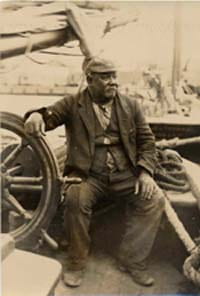“Thar she blows.”
Captain William Smith was at the wheel of the whaling barque, Marie Laure. Below him, on the deck, he could see his brother-in-law, Domingo Jose Evorall, readying the small rowboat. William knew the danger involved in chasing and harpooning a sperm whale.
“Lines in the boats.”
William remembered a time many years previously when he and his fellow shipmates were putting the lines carefully in place, fixing the pins and adding the harpoons. Boats were lowered, swinging dangerously close to the side of the rolling barque. Near the waves, the boats were quickly unhooked, sailors got oars ready to push against the sides if they got too close to the barque. It was then that the dangerous work began.
William, as mate, had been in charge of the chase and kept watch for the whale. The oarsmen pulled steadily. No time to look over their shoulders. The green hands, on their first chase, were they frightened or excited? Spouts were seen close by.
“Heave to.”
The iron was thrown; the flukes suddenly hit the water and sprayed the sailors.
“Stern for your lives.”
Boatsteerer making sure the boat doesn’t overturn; harpooner ready with a knife to cut the slack line if needed; the whale sounding or diving deep. A drogue was now attached to the line to slow the speed of the diving whale. The line going slack but where is the big cetacean? Suddenly, great jaw open, he breaks the surface just in front of us.
…………………………………………………
Much of the language for this was taken from a PDF document of an actual whale chase that William took part in in 1862. I had four students leave comments mainly about not knowing where and when the present time and the thoughts of William changed from one to the other. They said they got very involved with the story and could feel the excitement of the chase.
Readers: Where else could I improve this writing? As it is only going to be published on this blog, feel free to re-write whole paragraphs if you want.

